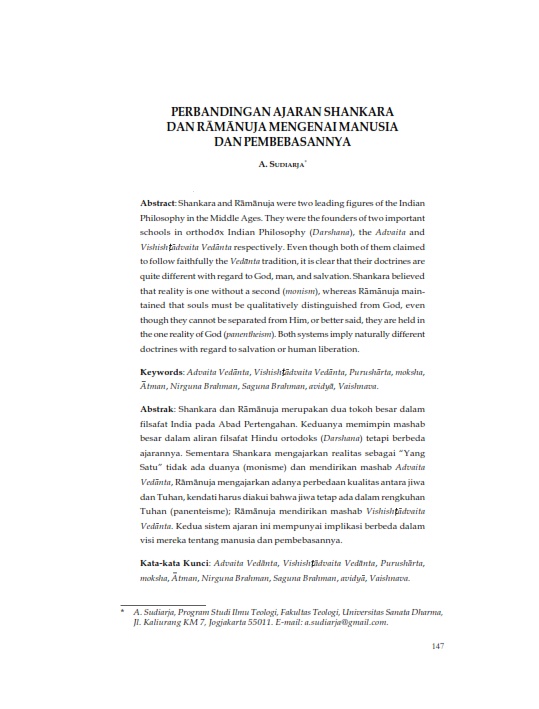Perbandingan Ajaran Shankara Dan Ramanuja Mengenai Manusia Dan Pembebasannya
Abstract
Abstract: Shankara and Ramanuja were two leading figures of the Indian Philosophy in the Middle Ages. They were the founders of two important schools in orthodox Indian Philosophy (Darshana), the Advaita and Vishish advaita Vedanta respectively. Even though both of them claimed to follow faithfully the Vedanta tradition, it is clear that their doctrines are quite different with regard to God, man, and salvation. Shankara believed that reality is one without a second (monism), whereas Ramanuja main- tained that souls must be qualitatively distinguished from God, even though they cannot be separated from Him, or better said, they are held in the one reality of God (panentheism). Both systems imply naturally different doctrines with regard to salvation or human liberation.
Keywords: Advaita Vedanta, Vishish advaita Vedanta, Purusharta, moksha, Atman, Nirguna Brahman, Saguna Brahman, avidya, Vaishnava.
Abstrak: Shankara dan Ramanuja merupakan dua tokoh besar dalam filsafat India pada Abad Pertengahan. Keduanya memimpin mashab besar dalam aliran filsafat Hindu ortodoks (Darshana) tetapi berbeda ajarannya. Sementara Shankara mengajarkan realitas sebagai “Yang Satu” tidak ada duanya (monisme) dan mendirikan mashab Advaita Vedanta, Ramanuja mengajarkan adanya perbedaan kualitas antara jiwa dan Tuhan, kendati harus diakui bahwa jiwa tetap ada dalam rengkuhan Tuhan (panenteisme); Ramanuja mendirikan mashab Vishish advaita Vedanta. Kedua sistem ajaran ini mempunyai implikasi berbeda dalam visi mereka tentang manusia dan pembebasannya.
Kata-kata Kunci: Advaita Vedanta, Vishish advaita Vedanta, Purusharta, moksha, Atman, Nirguna Brahman, Saguna Brahman, avidya, Vaishnava.

DISKURSUS applies the Creative Commons license (CC BY). We allow readers to read, download, copy, distribute, print, search, or link to the full texts of its articles and allow readers to use them for any other lawful purpose. Full information about CC BY can be found here: https://creativecommons.org/licenses/by/4.0/












